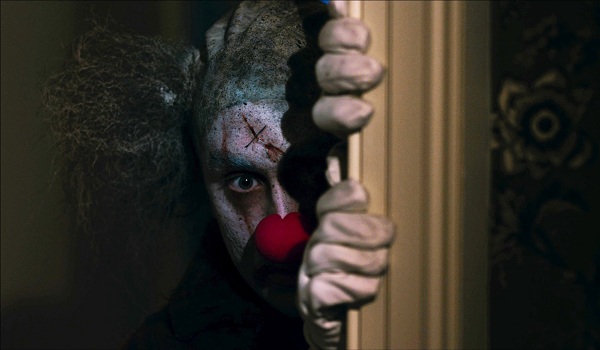After a children’s party clown’s act is cut short when he dies on the job, years later he’s back from the dead to make sure his next party is a scream. Director Conor McMahon discusses his new movie Stitches, out on VOD and DVD now.
Why a clown?
I wanted to do a comedy horror slasher film, and I was trying to cram every idea into that and at the same time I was also working on a real life serial killing thing and it wasn’t working that way. Eventually, I decided a clown would be the perfect fit to do something funny and silly, because it gives you an opportunity to do funny over the top death scenes and use his props that he has, and it was something I hadn’t seen in a while.
How is this movie different from other horror movies about clowns?
When I was doing it I was very conscious of IT, obviously, which I saw when I was a kid. So one of the main things was to try and avoid what people’s perceptions were, even in the design of the costume and not go for the red hair and the standard things people think about. Stitches is almost more of a comedy than a horror movie so, for me the death sequences are sort of the star of the show in a way. We tried to get a balance of the two where as something like IT I think was more pure horror.
How did Ross Nobel get involved with the project?
I knew Ross as a stand-up comedian, and his act is very physical and quite funny. And he is quite a big horror fan, I think when we sent him the script his response was “You had me at the pie in the face”. What I didn’t know is that he used to be a clown himself, so he had lots of hatred that he could channel into this very easily. He’s supposed to be a kind of shoddy clown in this and one of the problems he had actually was doing things badly, he knew how to do it so well in real life that it was a bit hard for him to mess it up.
You’re a director, editor, and writer. What have you learned by doing those different roles that you are able to bring with you working on other films?
If you’re on set if you’re an Editor then you can kind of make those decisions on the spot and know that you have the right footage or that you only need that bit or that bit and it will work instead of having to worry and defer to someone else. You can kind of cut in your head as you shoot. As a director, especially in Ireland, everyone is kind of a writer by default when you’re first starting out because no one at the beginning is really sending you scripts, so you have to create your own material. As I go on I work with other writers, but it’s really something you have to do to get things started.
What was the scariest movie moment for you as a child?
There were two. I convinced my Mom to see the movie Aliens and the part where Bishop gets torn in half haunted me for a long time. I don’t know how I convinced her that Aliens was some sort of art movie, but she kind of bought it. And the other one, not really a horror film, but Robocop, where he got run over and hit by the car. And the way we got to see that was my Uncle who was letting us watch it, people tried to convince him he shouldn’t be and he just would brush it off and say “Oh, nah! It’s just like the Tin Man from Wizard of Oz”.
What are you personally afraid of?
Things I don’t like, definitely heights. Spiders, hate spiders! I hate flying as well. I can’t look forward to anything when it’s abroad, so a bit of a problem, I’m terrified of going and then when I’m there I’m sort of terrified to go home again.
You worked on a Black and white silent short called The unusual inventions of Henry Cavendish as an editor and had little role in it as a newspaper boy. You also wrote a silent short of your own called 1902. What’s the appeal of a silent project and how do you think that experience influences your other work?
I think it’s always good, even when I’m writing a scene I try and think of it just without dialogue telling the story visually. Back at that time we had found an old Bolex camera, we were in college just experimenting. There’s something really fun about it, it forces you to be a bit more creative. Sometimes the go-to is just to explain it and say the words, but I think this way you get more interesting ways of doing it.
By Laura Gaddy

